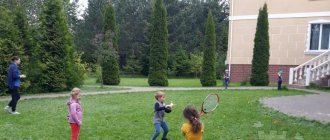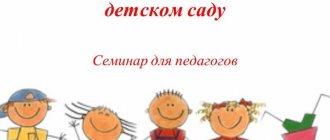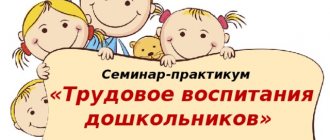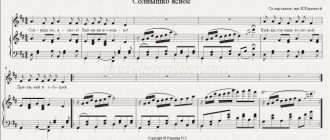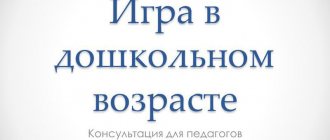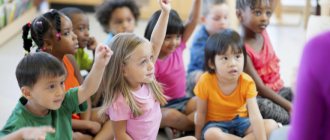Author - A.D. Kandykova
The purpose of the game in kindergarten is to enhance the activities of teachers in multicultural education of children. Preliminary work includes consultation, teaching hour, study of regulatory and methodological documents.
Materials and equipment:
- sheets with tasks for the number of participants, crossword puzzles;
- ICT is used to demonstrate the stages of the game and solved crossword puzzles - a projector, a computer, a screen.
Progress of the game
In the music room there are tables in a semicircle, teachers sit at them. The game is conducted by the presenter.
The business game for teachers takes place in three stages:
- at the first stage, teachers work individually,
- at the second stage they unite in pairs,
- at the third stage - into three groups with an equal number of participants.
The jury evaluates the work of teachers in pairs and groups according to the following criteria: completeness of the answer, coherence of work in pairs and groups (the ability to correctly defend one’s opinion and negotiate with colleagues). The jury's individual work is not evaluated.
Stage 1
1. Read statements from different authors about multicultural education. 2. Underline the words that express the essence of the statement. 3. Write down how you understand the essence of multicultural education. 4. Sketch out the main meaning of multiculturalism (in your opinion).
A.N. Dzhurinsky considers multicultural education as an alternative to international socialist education, the formation of personality outside of national culture, subject to the unity and ideological integration of society. At the same time, multicultural education places emphasis on the interconnection of cultures, one of which dominates.
M.A. Bogomolova proceeds from the fact that multicultural education in its essence is close to interethnic education and provides for interpersonal interaction and is opposed to nationalism and racism. It is aimed at mastering cultural and educational values, at the interaction of different cultures in a situation of pluralistic cultural adaptation to other cultural values.
V.V. Makaev., Z.A. Malkova, L.L. Suprunov identify multicultural education with the formation of the personality of a person capable of active and effective life in a multinational and multicultural environment, who has a developed sense of understanding and respect for other cultures, the ability to live in peace and harmony with people of different nationalities, races, and religions.
A number of authors (N.D. Galskova, L.L. Paramonova, V.V. Safonova, E.A. Sokolova) associate the willingness to accept another culture, another way of life with manifestations of tolerance, because only mutual tolerance of people of different nationalities can resist hatred .
Stage 2
Team up in pairs based on a common characteristic (exclude the sign of working in the same age group). Tell your partner how you understand multicultural parenting. Explain your multicultural framework. Draw a general diagram of multiculturalism.
1. Read the meanings of the words “tolerance” and “ethno-” taken from dictionaries. 2. Based on them, create your definition of ethnotolerance.
The meaning of the word "tolerance"
"Wikipedia" Tolerance - from lat. tolerare - endure, endure, endure, get used to. “Social tolerance” in sociology and psychology is tolerance, the ability to calmly, without hostility, perceive someone else’s way of life, behavior, customs, feelings, opinions, ideas, beliefs, recognize the right to exist of other cultures and coexist sustainably in a multicultural, multi-ethnic society.
Dictionary of Foreign Words Tolerance (Latin tolerantia - patience) - 1) tolerance, condescension towards someone or something; 2) biol., med. complete or partial absence of immunological reactivity, i.e. loss (or decrease) by the animal or human body of the ability to produce antibodies in response to antigenic irritation (cf. sensitization 1).
Modern explanatory dictionary Tolerance (from Latin tolerantia - patience) - 1) an immunological state of the body in which it is unable to synthesize antibodies in response to the introduction of a specific antigen while maintaining immune reactivity to other antigens. The problem of tolerance is important in organ and tissue transplantation...; 2) the body’s ability to tolerate the adverse effects of one or another environmental factor...; 3) tolerance for other people's opinions, beliefs, and behavior.
The meaning of the word “ethno-” The initial part of complex words that introduces the meaning of the word people (ethnogenesis, ethnolinguistics, ethnopsychology, etc.).
Stage 3
Form three groups with an equal number of participants.
I. Solve the crossword puzzle for the section of the “Childhood” program - “Child in a multicultural and multiethnic environment”
Questions of the 1st crossword puzzle 1. One of the components of the content of social development of older preschool children in a multicultural society. 2. Spiritual _______ and especially art become the most valuable for the upbringing and education of preschool children. 3. A socio-cultural phenomenon that has great potential for introducing preschool children to different cultures. 4 and 5. Two forms of folk play culture, understandable and interesting to children. 6. Works of decorative and applied art of different peoples reflect the traditional cultural values of ___________________________. 7. Mastering what helps preschoolers understand the commonality of moral and ethical universal values?
Questions of the 2nd crossword 1. One of the forms of folk gaming culture, understandable and interesting to children. 2. One of the components of the content of social development of older preschoolers in a multicultural society. 3. The value (one of three) of oral folk art. 4. The commonality in the images of folk and decorative crafts is determined by the unity of moral and aesthetic ____________________________________. 5. Works of different types of art are close to the emotional manifestation of a child, his ability to think in images and express his attitude to the environment in different types of ________________ activities. 6. One of the three components of ethnotolerance.
Questions of the 3rd crossword puzzle 1. The specificity of folk decorative crafts of different cultures (differences in images) depends on _____________ characteristics of the life of the ethnic group. 2. One of the components of the content of social development of older preschoolers in a multicultural society. 3. One of the three components of ethnotolerance. 4. The value (one of three) of oral folk art. 5. Spiritual culture and especially ________ become the most valuable for the upbringing and education of preschool children. 6. One of the forms of folk gaming culture, understandable and interesting to children.
II. Complete the task.
Task 1 List the main methods of instilling ethnic tolerance in children aged 5-6 years. Continue the phrase: “The use of these methods ensures and promotes...”
Task 2 List the methods of teaching ethnic tolerance in children 6-7 years old that were not used in the older group. Reveal the essence of the project method in senior and preparatory groups.
Task 3 Tell us in detail about the method “Comparative analysis of folk games, toys, works of folk art.” Make a plan for the theme day “Children of the whole Earth are friends” (recommended for holding by the authors of the “Childhood” program).
Decide who will speak for your group. An exchange of views is taking place.
MULTICULTURAL EDUCATION OF PRESCHOOL CHILDREN
Author: Mishkina Elena Petrovna
MULTICULTURAL EDUCATION OF CHILDREN
PRESCHOOL AGE
“Man is a unique world of cultures, interacting with other individuals - cultures, creating himself in the process of such interaction and influencing others”
MM. Bakhtin
“A people who do not know their culture and history are despicable and frivolous”
N.M. Karamzin
The social processes taking place in modern society create the prerequisites for the development of new educational goals. In the modern educational system, the center is the person who is brought up and develops in a multicultural space. The federal state standard defines unified educational processes of preschool education, focused on the formation of a citizen who loves his people, his region, his homeland, and is tolerant of the culture, traditions and customs of other peoples. Tolerance, friendliness, respect for people of different nationalities are not inherited, they must be brought up again in each generation, and the earlier the formation of these qualities begins, the more stability they acquire
The concept of “multicultural education” is defined differently today.
Multicultural education is a complex, versatile process of personal socialization, based on the continuity of culture, traditions and norms.
The problem of multicultural education of preschool children in modern conditions of the development of a multicultural society acquires particular relevance. At present, when there is an intensive process of humanization of our multinational society, the upbringing and education of the younger generation in the traditions of national culture and customs is becoming extremely important. V.V. Putin emphasizes that “the interaction of different cultures is a centuries-old tradition of our social and state life, and the national diversity of the peoples of Russia is the true wealth of the country. And therefore we fully support activities aimed at establishing a culture of peace and tolerance as necessary conditions for the dialogue of civilizations.”
The concept of preschool education sets the task of acquiring the foundations of personal culture, its basis, corresponding to universal spiritual values. The formation of a multicultural personality is determined by specific tasks of multicultural education of preschool children:
- development of ideas about the development of humanity, about the way of life of man in ancient times;
- developing children's ideas about the diversity of cultures in Russia and the world, introducing children to the cultural wealth of the Russian people through traditions and customs, games, folklore, and fostering a positive attitude towards different cultures;
— instilling in preschoolers the skills and abilities of productive interaction with speakers of different cultures;
— education in children of patriotism, tolerance, humanity in relation to other cultures.
— fostering respect for the personality and rights of another person, social norms and rules of behavior.
The scientifically based content of multicultural education includes components of national cultures: oral folk art, folk songs, arts and crafts, games, traditions.
Familiarization of preschool children with national cultures is realized through the integration of educational areas
“Cognitive development”, “Speech development”, “Socio-communicative development”, “Artistic and aesthetic development”. “Physical development” also makes its contribution to solving these problems, since the formation of physical qualities, motor skills and abilities is closely related to the development of moral and volitional personality traits. Physical education must be considered more broadly - as a pedagogical process of personal development. A physically developed person, strong, strong, healthy, must be kind, tolerant, must be able to come to the aid of those who need it and direct his skills and strength only to good deeds.
Outdoor games
- the most accessible and effective method of developing a child’s personality with his active help. Play is a natural companion of life and therefore meets the laws laid down by nature itself in the developing body of a child - his insatiable need for cheerful movements. It is the game that gives the child the opportunity to “live” for himself what he learned about in the process of direct educational activity. Stories about folk traditions will not achieve their goal if they do not find continuation in games, visual, and theatrical activities. Outdoor games contribute to the development of conscious discipline, will, perseverance in overcoming difficulties, and teach children to be honest and truthful.
Using folk outdoor games in various forms of physical education and health work, we can solve developmental, health-improving tasks, as well as educational ones aimed at developing the child’s personality and tolerant relationships in the children’s team. Folk outdoor games are of particular importance
which children love to play. The joy of movement is combined with the spiritual enrichment of children. Through the game, they develop a stable attitude towards the culture of their native country, creating an emotionally positive basis for the development of patriotic feelings. Their solution is more effective when working with children of senior preschool age, since it is this age that is sensitive for the education of morality, and it is at this age that the foundation is laid for the further development of the child’s personality.
In our kindergarten, like in many others nowadays, children of different nationalities are brought up together. We must try to make our home truly kind, warm, bright for everyone who, for one reason or another, came to it and lives with us. But most of the children are Russian, so it is necessary to begin multicultural education with familiarization with Russian culture.
In working with children to familiarize them with the national culture and traditions of the Russian people, entertainment, various conversations about children's games in the distant past are held in kindergartens, and forgotten folk games are actively used in working with children. Folk games are important in the formation of an individual's ethnic self-awareness. Games cultivate love and respect for one’s people, and develop a desire to comprehend the richness of national culture.
Russian folk games
have a long history, they have been preserved and reached our days from ancient times, passed down from generation to generation, absorbing the best national traditions.
Particularly popular and beloved were games such as burners, Russian lapta, blind man's buff, gorodki, and ball games.
The game
“Blind Man's Bluff”
was widespread in many regions of Russia and had different names:
“Blind Frying Pan”, “Zhmachki”
,
“Night Blindness”, “Crooked Rooster”
, etc. Before starting the game, the children had a chorus conversation with the driver: “Cat, cat, what are you standing on?” - “In the kettle.” - “What’s in the kneader?” - “Kvass!” - “Catch mice, not us!” They will talk to the driver like this, and also make him turn around in one place several times, and only after that he begins to look for the players, as a rule, with their eyes closed.
There are many games where the success of the players depends, first of all, on the ability to accurately throw a bat, knock down towns, catch a ball or hit a target with a ball (towns, lapta, etc.). Both the names of the games and the rules were different in different regions of Russia, but what they had in common was the desire to win, to gain victory.
Calendar folk games are an invaluable national treasure.
.
They are of interest not only as a genre of oral folk art. They contain information that gives an idea of the daily life of our ancestors - their way of life, work, worldview. The names of the games confirm this. For example, games such as “ Boyars”, “ Tsar Gorokh”, “ Archery”, “The Herd”, “Zhmurki”,
etc., indicate that people once took part in military campaigns, battles, kept the farm has a variety of livestock and poultry, reflecting the way of life during the reign of monarchs in the Russian state. Games were an indispensable element of folk ritual holidays.
In folk games there is a single goal and uniformity of actions; songs, words and movements are organically connected. The games are varied in content and organization. Some of them have a plot, their rules are closely related to the plot (for example, “ Kite”, “Hen”, “Geese-Swans”, “The Herd”
).
And in games like “Three is enough, two is enough”, “Hot Seat”
there is no plot and roles, all children’s attention is directed to movement and rules.
There are games in which the plot and actions of the players are determined by the text. In the game “Paints”
the buyer talks to the driver: “Knock-knock!” - "Who's there?" - "Buyer". - “Why did you come?” - “For paint.” - “For which one?” - “For blue.”
Collective activities in games contribute to the formation and development of a child’s communicative culture, which is also very important in the education of multiculturalism. Almost all games are designed for the participation of a group of children, which forces each participant to equally submit to the will of all players. There are many different games to test your collective strength. With the help of collective games, children are taught to communicate with each other, mutual services and respect for common interests. Games contribute to the emergence of competition among children and, as a result, recognition of advantages or disadvantages; those who showed a high level of physical qualities are encouraged, those who lose are condemned.
Each participant in the game must study and master the norms, rules of relationships and behavior that are mandatory for all players. Only then can we talk about the child as a worthy participant in the game.
The educational significance of children's games is further enhanced by the fact that a unique system of rewards and punishments is used in their process. Incentives consist of the fact that the winner is the first to start the next game, receives the right to play the game, choose a partner, and assign punishments to the loser. The punishments in the games are very varied: to be carried on the back, to stand guard out of turn, to dance or sing in a circle of participants.
In folk games there are many songs and nursery rhymes, funny counting rhymes, and lots. They have retained their artistic identity and constitute a valuable, unique gaming folklore.
Children really like various songs in Russian games.
In the game
“Corners,”
each dash is accompanied by a song.
At the last word, the players change places, and the buyer and driver strive to occupy the corner vacated during the dash. In games like “Burners,”
the text distracts the attention of the catcher; while singing, he must look up.
Children are also attracted to fun games with inventing absurdities, puns, funny movements, gestures, and “ransoming” forfeits. For example, “The Greek was once driving across the river...”
, etc. The jokes and humor characteristic of them are inherently harmless. The friendly laughter of partners - children and close adults, comrades - has a stronger effect on the child than remarks and punishments. Children widely use games learned in class in independent activities.
Solving the problems of multicultural education occurs more effectively when the national culture is naturally woven into the life of the kindergarten group, and is carried out through the joint efforts of all teachers and kindergarten specialists and parents
.
The purpose of this interaction is to transmit the amount of knowledge necessary for an older preschooler to develop ideas about a person in the fields of history and culture, foster a sense of love for his homeland, and familiarize himself with the past and present of national culture.
All preschool teachers, through various forms of work, should introduce children to folk games, the folk calendar, works of folk applied art, folklore, the foundations of Orthodox culture, traditions, way of life, customs of the Russian people, peasant labor, which contributes to the development of cognitive abilities in children, the formation of high morality, fosters love for the Fatherland, respect for ancestors, and interest in the original Russian culture. “The affairs of days gone by, the legends of deep antiquity...” become closer and more understandable to the child. For this purpose, a special environment must be created in kindergartens and groups in order to familiarize children with folk culture and folk art.
Local history corners are welcome in each group
(albums, folders and didactic games: “My Family”, “My City”, “State Symbols of Russia”, “Moscow is the Capital of Russia”, “Defenders of the Fatherland”, “Heroes of the Russian Land”, flag, coat of arms, anthem of Russia, mini -Museum “Russian Izba”, etc.); selections of didactic, role-playing, Russian folk, round dance, sedentary, outdoor games; as well as a selection of methodological and children's fiction, poetry, folk proverbs and sayings about patriotism, heroism, courage, etc.
In corners for parents
The material on the folk calendar, on Russian cuisine, on the folk holidays
“Easter”, “Christmas”, New Year”, “Maslenitsa”
and others should be updated.
Along with directly organized activities, teachers, together with music. employees organize holidays :
calendar, folklore, ritual, name days
, etc. Calendar folk holidays are a unique opportunity for children and adults to annually immerse themselves in the world of folk songs, dances, rituals, games and naturally master the spiritual experience of their people.
Our kindergarten regularly hosts such folk holidays as: Autumn gatherings, Maslenitsa, Easter, Winter Christmastide, etc.,
in which both adults and children are active participants. When developing a script for a national holiday, special attention is paid to the selection of verbal, musical, dramatic, game and choreographic works of ritual and calendar folklore and, of course, folk outdoor games. Most boys want to be like heroes - defenders of the Fatherland: they want to be bold, courageous, strong, able to overcome any difficulties and obstacles in their path. It is necessary to support and encourage these desires by involving children in theatrical performances, sports competitions, constantly introducing them to the customs of the Russian people and cultivating love for their Motherland!
Particular attention should be paid to strengthening ties with parents
.
Currently, this work is relevant and especially difficult, requiring great tact and patience, since in young families the issues of educating multiculturalism and citizenship are not considered important, and often only cause bewilderment. Working with families in the field of multicultural education of children requires serious reflection, non-traditional approaches and forms, otherwise the efforts of teachers will be in vain. We must try to ensure that parents become active participants in the pedagogical process: they take part in various matinees, entertainment, Russian folk holidays, in making attributes ,
in decorating the group, and actively discussing issues of education at parent meetings and seminars.
Our Russia is a multinational country. Since ancient times, many peoples have lived on its territory, each of which is unique in its own way and has rich traditions. This is especially important for our region, where since ancient times different nationalities have lived side by side in friendly relations, constantly interacting with each other. Friendliness and a tolerant attitude towards people of different nationalities are fostered through children’s acquisition of a certain range of knowledge about other peoples: the place of residence of each of them, the main city, the natural conditions of the region, and folk culture. Folklore is used, which tells in detail about the peoples inhabiting the territory of Russia: about Russians, about the peoples of the south and north of the European part of Russia, the North Caucasus, the Volga region, the Urals, the North, Siberia, the Far East.
Thus, folk outdoor games in combination with other educational means represent the basis of the initial stage of the formation of a harmoniously developed, active personality, combining spiritual wealth, moral foundation and physical perfection. The joy of movement is combined with the spiritual enrichment of children. Through the game, a stable attitude towards the culture of the native country is formed, an emotionally positive basis is created for the development of patriotic feelings.
Bibliography:
1. Keneman A.V. , Osokina T.I. “Children’s folk outdoor games” - M.: 1995, - 224 p.
2. M.F. Litvinova. Russian folk outdoor games for preschool and primary school children: A practical guide. – M.: Iris-press, 2003.
3. O.L.Knyazeva, M.D.Makhaneva. Introducing children to the origins of Russian folk culture: Program. Educational and methodological manual. – St. Petersburg: Childhood-Press, 2004.
4. The folk calendar is the basis for planning work with preschoolers according to the state educational standard: Plan-program.
Lesson notes. Holiday scenarios: Methodological manual for teachers of preschool educational institutions / Nikolaeva S.R., Katysheva I.B., Kombarova G.N., etc. - St. Petersburg: “CHILDHOOD-PRESS”, 2004. comments powered by HyperComments
Literature
- Babaeva T.I. Childhood. Sample basic general education program for preschool education. - St. Petersburg, 2011. - pp. 498-508.
- Babaeva T.I. Monitoring in kindergarten: scientific method. allowance. - St. Petersburg, 2011. - pp. 172-189.
- Evdokimova E. S. Design technology in preschool educational institutions. - M., 2006.
- Losev P. N. Management of methodological work in a modern preschool educational institution. - M., 2005.
- Shmonina L.V. Innovative technologies in the methodological work of preschool educational institutions: planning, forms of work. - Volgograd, 2011.
Material provided by the magazine PRESCHOOL PEDAGOGY, No. 1, 2014.
